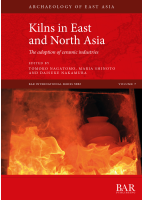Description
This is an open access title available under the terms of a CC BY-NC-ND 4.0 License. It is free to read, download and share on the BAR Digital platform here.
The start of ceramic industry is an important stage in mass production and is closely related to social complexity and social exchanges including the immigration of specialists. The introduction of high-temperature operations and varying firing regimes is a technological breakthrough in ceramic production. This book discusses the introduction and the background of kilns and advanced technology in the wider area of East Asia, covering the early appearances of the typical East Asian kiln technology in China, and its distribution to the Russian Far East, the Korean peninsula, and the central Japanese archipelago. Using both scientific and archaeological analysis, this book tries to help better understand the introduction factors of kilns, management of kilns by each regime, and the development of technology. An extensive glossary at the end of the book orientates readers not familiar with research in East Asia or languages referenced in this book.
EDITORS
Tomoko Nagatomo is Professor at the Department of Archaeology and Cultural Heritage, Ritsumeikan University. Her main interest is the archaeology of Japan and Korea, rice-farming societies, state formation, pottery production, and ethnoarchaeology in Southeast Asia.
Maria Shinoto is Associate Professor (Privatdozentin) at the Institute for Prehistory, Protohistory and Near Eastern Archaeology, Heidelberg University. Her main interest is the archaeology of South Japan, pottery, pre-Buddhist iconography (sōshoku-kofun), and the integration of technical and scientific research into archaeological studies.
Daisuke Nakamura is Associate Professor at the Faculty of Liberal Arts, Saitama University. He is currently involved in field work in Mongolia besides studies in Korea, China, and Japan, and his main research interests are nomadism and agriculture, burial systems, trade, and ethnoarchaeology.
Contributors: Michèle H. S. Demandt, Zheng Jianming, Masaaki Kidachi, Katsuhiko Kiyama, Sungjoo Lee, Yūsuke Mukai, Tomoko Nagatomo, Daisuke Nakamura, Naoko Nakamura, Maria Shinoto, Akito Shinzato, Johannes H. Sterba, Isao Usuki, Takafumi Yamamoto, Irina Zhushchikhovskaya.
REVIEWS
‘This is a significant contribution to the field of ceramic studies in East Asia, particularly given the dearth of English-language material on early kilns in Korea and Japan. The data provided here will be of significant interest to ceramics researchers working in other parts of the world who are looking for examples of kiln construction, use, innovation, and technological circulation.’ Dr Andrew Womack, Furman University
‘The book ambitiously encompasses a broad geographical area, in which kilns firstly developed, with the consideration of their historical, economical, and social backgrounds. It also combines archaeological and scientific methods, considering not only the technological dimensions of kilns but also their life history, the changing values of products, and cultural influences of difference sources.’ Dr Kuei-chen Lin, History and Philology, Academia Sinica











